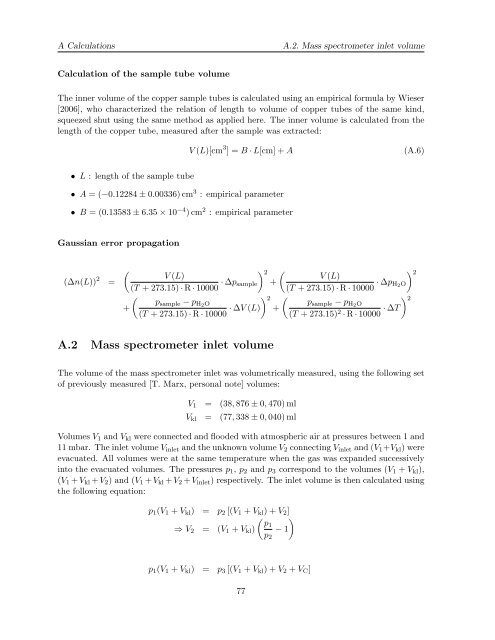Diploma thesis in Physics submitted by Florian Freundt born in ...
Diploma thesis in Physics submitted by Florian Freundt born in ...
Diploma thesis in Physics submitted by Florian Freundt born in ...
Create successful ePaper yourself
Turn your PDF publications into a flip-book with our unique Google optimized e-Paper software.
A Calculations A.2. Mass spectrometer <strong>in</strong>let volume<br />
Calculation of the sample tube volume<br />
The <strong>in</strong>ner volume of the copper sample tubes is calculated us<strong>in</strong>g an empirical formula <strong>by</strong> Wieser<br />
[2006], who characterized the relation of length to volume of copper tubes of the same k<strong>in</strong>d,<br />
squeezed shut us<strong>in</strong>g the same method as applied here. The <strong>in</strong>ner volume is calculated from the<br />
length of the copper tube, measured after the sample was extracted:<br />
• L : length of the sample tube<br />
• A = (−0.12284 ± 0.00336) cm 3 : empirical parameter<br />
• B = (0.13583 ± 6.35 × 10 −4 ) cm 2 : empirical parameter<br />
Gaussian error propagation<br />
(∆n(L)) 2 =<br />
V (L)[cm 3 ] = B · L[cm] + A (A.6)<br />
�<br />
V (L)<br />
· ∆psample<br />
(T + 273.15) · R · 10000<br />
�<br />
psample − pH2O<br />
+<br />
· ∆V (L)<br />
(T + 273.15) · R · 10000<br />
A.2 Mass spectrometer <strong>in</strong>let volume<br />
� 2<br />
� 2<br />
�<br />
V (L)<br />
+<br />
· ∆pH2O<br />
(T + 273.15) · R · 10000<br />
�<br />
psample − pH2O<br />
+<br />
(T + 273.15) 2 · ∆T<br />
· R · 10000<br />
The volume of the mass spectrometer <strong>in</strong>let was volumetrically measured, us<strong>in</strong>g the follow<strong>in</strong>g set<br />
of previously measured [T. Marx, personal note] volumes:<br />
V1 = (38, 876 ± 0, 470) ml<br />
Vkl = (77, 338 ± 0, 040) ml<br />
Volumes V1 and Vkl were connected and flooded with atmospheric air at pressures between 1 and<br />
11 mbar. The <strong>in</strong>let volume V<strong>in</strong>let and the unknown volume V2 connect<strong>in</strong>g V<strong>in</strong>let and (V1+Vkl) were<br />
evacuated. All volumes were at the same temperature when the gas was expanded successively<br />
<strong>in</strong>to the evacuated volumes. The pressures p1, p2 and p3 correspond to the volumes (V1 + Vkl),<br />
(V1 + Vkl + V2) and (V1 + Vkl + V2 + V<strong>in</strong>let) respectively. The <strong>in</strong>let volume is then calculated us<strong>in</strong>g<br />
the follow<strong>in</strong>g equation:<br />
p1(V1 + Vkl) = p2 [(V1 + Vkl) + V2]<br />
� �<br />
p1<br />
⇒ V2 = (V1 + Vkl) − 1<br />
p1(V1 + Vkl) = p3 [(V1 + Vkl) + V2 + VC]<br />
77<br />
p2<br />
� 2<br />
� 2
















